Critical Analysis: Australian Diabetes Management Program for NCDs
VerifiedAdded on 2022/10/01
|14
|3770
|107
Report
AI Summary
This report provides a critical analysis of the Australian Diabetes Management Program, focusing on its strategies to address non-communicable diseases (NCDs). It begins with an introduction to healthcare management and the importance of clinical evidence in developing guidelines, particularly in the Australian context. The report then provides an overview of the diabetes management program, highlighting its goals of prevention, treatment, management, and research across different population sets. It examines the role of the program and its targeted communities, including children, teenagers, adults, and specific populations like Aboriginal and Torres Strait Islander communities. The report analyzes the program's multidimensional approach, its stakeholders, and the guiding principles based on clinical evidence. A critical analysis is provided, evaluating the program's implementation, the involvement of healthcare practitioners, and the potential measures to improve community health. The report also discusses the challenges faced by the program, such as co-occurrence of diabetes with other conditions. Finally, the report emphasizes the importance of community inclusion and engagement in diabetes prevention and care management, highlighting the role of awareness and education in reducing risk factors and encouraging early diagnosis.

Non-communicable Diseases 1
Non-communicable Diseases
By (Name of Student)
Institution
City/State
Course Number
Professor
Date
Non-communicable Diseases
By (Name of Student)
Institution
City/State
Course Number
Professor
Date
Paraphrase This Document
Need a fresh take? Get an instant paraphrase of this document with our AI Paraphraser
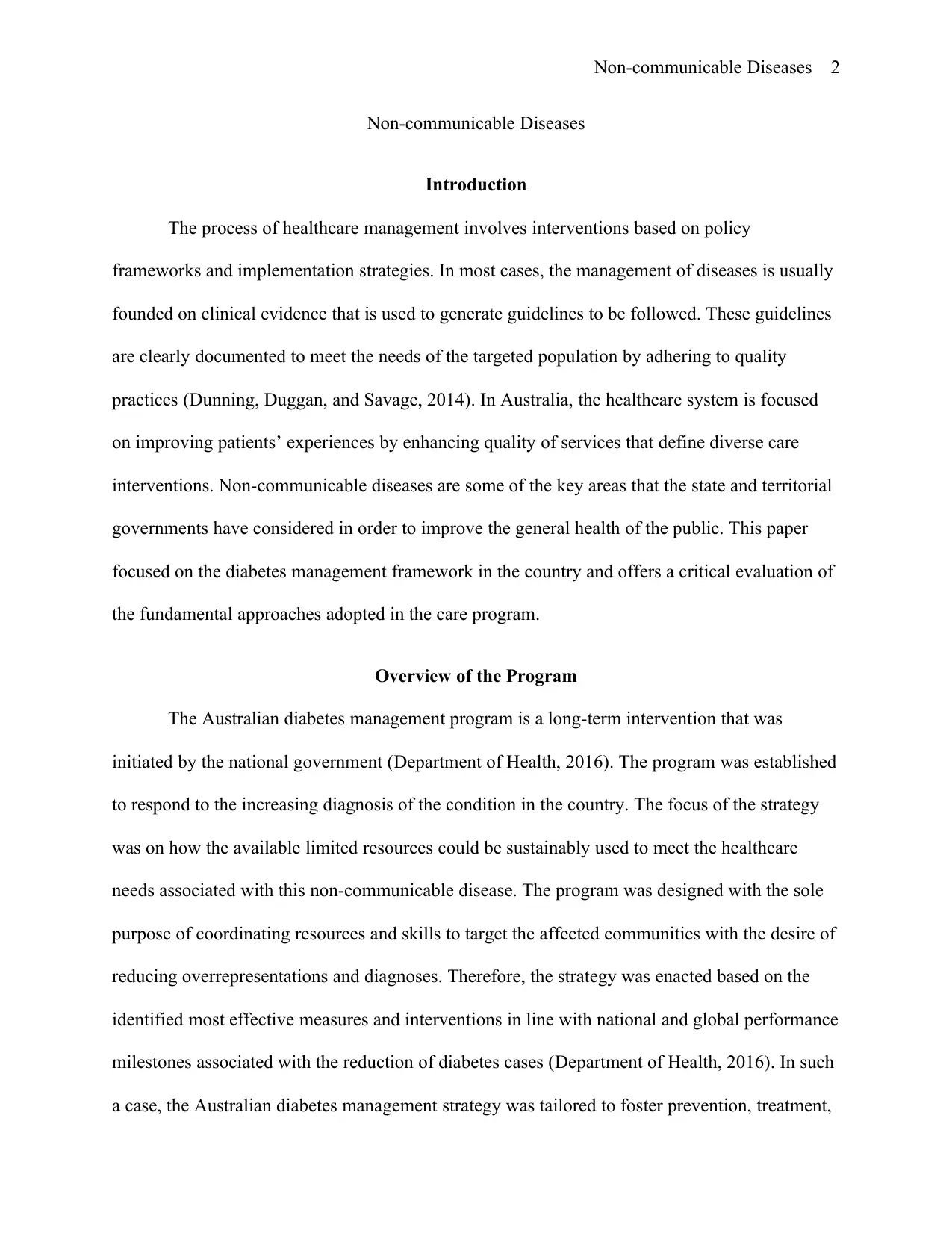
Non-communicable Diseases 2
Non-communicable Diseases
Introduction
The process of healthcare management involves interventions based on policy
frameworks and implementation strategies. In most cases, the management of diseases is usually
founded on clinical evidence that is used to generate guidelines to be followed. These guidelines
are clearly documented to meet the needs of the targeted population by adhering to quality
practices (Dunning, Duggan, and Savage, 2014). In Australia, the healthcare system is focused
on improving patients’ experiences by enhancing quality of services that define diverse care
interventions. Non-communicable diseases are some of the key areas that the state and territorial
governments have considered in order to improve the general health of the public. This paper
focused on the diabetes management framework in the country and offers a critical evaluation of
the fundamental approaches adopted in the care program.
Overview of the Program
The Australian diabetes management program is a long-term intervention that was
initiated by the national government (Department of Health, 2016). The program was established
to respond to the increasing diagnosis of the condition in the country. The focus of the strategy
was on how the available limited resources could be sustainably used to meet the healthcare
needs associated with this non-communicable disease. The program was designed with the sole
purpose of coordinating resources and skills to target the affected communities with the desire of
reducing overrepresentations and diagnoses. Therefore, the strategy was enacted based on the
identified most effective measures and interventions in line with national and global performance
milestones associated with the reduction of diabetes cases (Department of Health, 2016). In such
a case, the Australian diabetes management strategy was tailored to foster prevention, treatment,
Non-communicable Diseases
Introduction
The process of healthcare management involves interventions based on policy
frameworks and implementation strategies. In most cases, the management of diseases is usually
founded on clinical evidence that is used to generate guidelines to be followed. These guidelines
are clearly documented to meet the needs of the targeted population by adhering to quality
practices (Dunning, Duggan, and Savage, 2014). In Australia, the healthcare system is focused
on improving patients’ experiences by enhancing quality of services that define diverse care
interventions. Non-communicable diseases are some of the key areas that the state and territorial
governments have considered in order to improve the general health of the public. This paper
focused on the diabetes management framework in the country and offers a critical evaluation of
the fundamental approaches adopted in the care program.
Overview of the Program
The Australian diabetes management program is a long-term intervention that was
initiated by the national government (Department of Health, 2016). The program was established
to respond to the increasing diagnosis of the condition in the country. The focus of the strategy
was on how the available limited resources could be sustainably used to meet the healthcare
needs associated with this non-communicable disease. The program was designed with the sole
purpose of coordinating resources and skills to target the affected communities with the desire of
reducing overrepresentations and diagnoses. Therefore, the strategy was enacted based on the
identified most effective measures and interventions in line with national and global performance
milestones associated with the reduction of diabetes cases (Department of Health, 2016). In such
a case, the Australian diabetes management strategy was tailored to foster prevention, treatment,
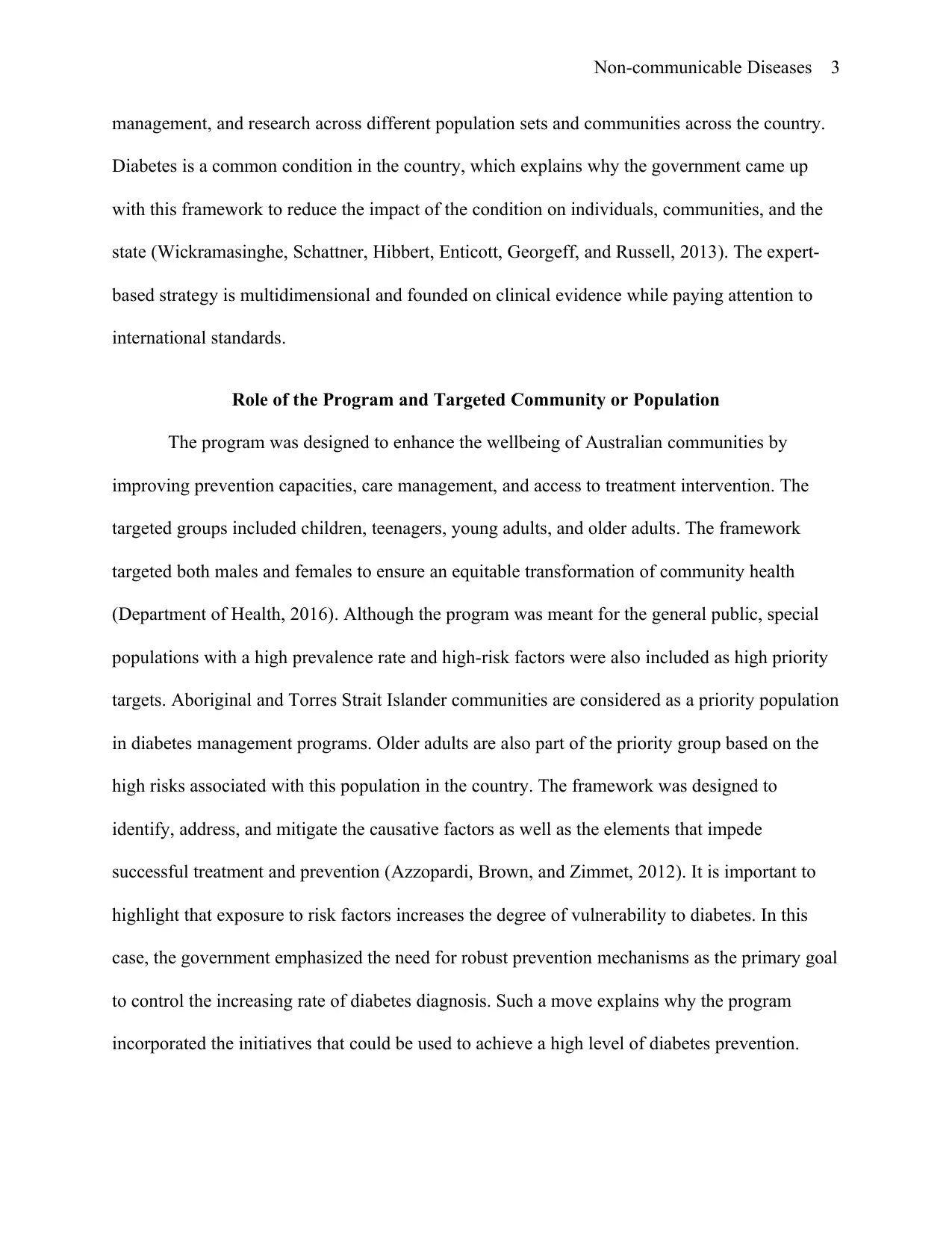
Non-communicable Diseases 3
management, and research across different population sets and communities across the country.
Diabetes is a common condition in the country, which explains why the government came up
with this framework to reduce the impact of the condition on individuals, communities, and the
state (Wickramasinghe, Schattner, Hibbert, Enticott, Georgeff, and Russell, 2013). The expert-
based strategy is multidimensional and founded on clinical evidence while paying attention to
international standards.
Role of the Program and Targeted Community or Population
The program was designed to enhance the wellbeing of Australian communities by
improving prevention capacities, care management, and access to treatment intervention. The
targeted groups included children, teenagers, young adults, and older adults. The framework
targeted both males and females to ensure an equitable transformation of community health
(Department of Health, 2016). Although the program was meant for the general public, special
populations with a high prevalence rate and high-risk factors were also included as high priority
targets. Aboriginal and Torres Strait Islander communities are considered as a priority population
in diabetes management programs. Older adults are also part of the priority group based on the
high risks associated with this population in the country. The framework was designed to
identify, address, and mitigate the causative factors as well as the elements that impede
successful treatment and prevention (Azzopardi, Brown, and Zimmet, 2012). It is important to
highlight that exposure to risk factors increases the degree of vulnerability to diabetes. In this
case, the government emphasized the need for robust prevention mechanisms as the primary goal
to control the increasing rate of diabetes diagnosis. Such a move explains why the program
incorporated the initiatives that could be used to achieve a high level of diabetes prevention.
management, and research across different population sets and communities across the country.
Diabetes is a common condition in the country, which explains why the government came up
with this framework to reduce the impact of the condition on individuals, communities, and the
state (Wickramasinghe, Schattner, Hibbert, Enticott, Georgeff, and Russell, 2013). The expert-
based strategy is multidimensional and founded on clinical evidence while paying attention to
international standards.
Role of the Program and Targeted Community or Population
The program was designed to enhance the wellbeing of Australian communities by
improving prevention capacities, care management, and access to treatment intervention. The
targeted groups included children, teenagers, young adults, and older adults. The framework
targeted both males and females to ensure an equitable transformation of community health
(Department of Health, 2016). Although the program was meant for the general public, special
populations with a high prevalence rate and high-risk factors were also included as high priority
targets. Aboriginal and Torres Strait Islander communities are considered as a priority population
in diabetes management programs. Older adults are also part of the priority group based on the
high risks associated with this population in the country. The framework was designed to
identify, address, and mitigate the causative factors as well as the elements that impede
successful treatment and prevention (Azzopardi, Brown, and Zimmet, 2012). It is important to
highlight that exposure to risk factors increases the degree of vulnerability to diabetes. In this
case, the government emphasized the need for robust prevention mechanisms as the primary goal
to control the increasing rate of diabetes diagnosis. Such a move explains why the program
incorporated the initiatives that could be used to achieve a high level of diabetes prevention.
You're viewing a preview
Unlock full access by subscribing today!
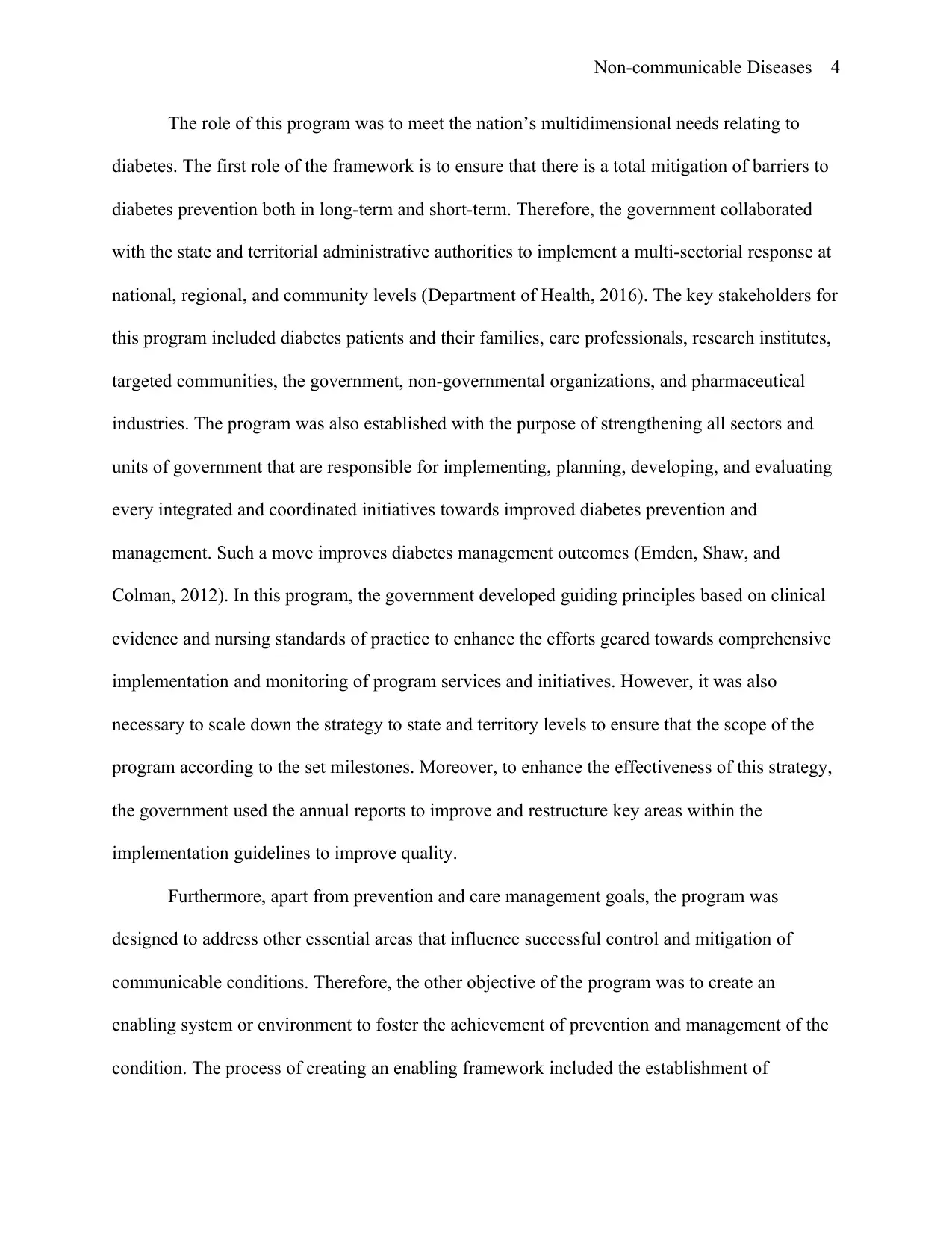
Non-communicable Diseases 4
The role of this program was to meet the nation’s multidimensional needs relating to
diabetes. The first role of the framework is to ensure that there is a total mitigation of barriers to
diabetes prevention both in long-term and short-term. Therefore, the government collaborated
with the state and territorial administrative authorities to implement a multi-sectorial response at
national, regional, and community levels (Department of Health, 2016). The key stakeholders for
this program included diabetes patients and their families, care professionals, research institutes,
targeted communities, the government, non-governmental organizations, and pharmaceutical
industries. The program was also established with the purpose of strengthening all sectors and
units of government that are responsible for implementing, planning, developing, and evaluating
every integrated and coordinated initiatives towards improved diabetes prevention and
management. Such a move improves diabetes management outcomes (Emden, Shaw, and
Colman, 2012). In this program, the government developed guiding principles based on clinical
evidence and nursing standards of practice to enhance the efforts geared towards comprehensive
implementation and monitoring of program services and initiatives. However, it was also
necessary to scale down the strategy to state and territory levels to ensure that the scope of the
program according to the set milestones. Moreover, to enhance the effectiveness of this strategy,
the government used the annual reports to improve and restructure key areas within the
implementation guidelines to improve quality.
Furthermore, apart from prevention and care management goals, the program was
designed to address other essential areas that influence successful control and mitigation of
communicable conditions. Therefore, the other objective of the program was to create an
enabling system or environment to foster the achievement of prevention and management of the
condition. The process of creating an enabling framework included the establishment of
The role of this program was to meet the nation’s multidimensional needs relating to
diabetes. The first role of the framework is to ensure that there is a total mitigation of barriers to
diabetes prevention both in long-term and short-term. Therefore, the government collaborated
with the state and territorial administrative authorities to implement a multi-sectorial response at
national, regional, and community levels (Department of Health, 2016). The key stakeholders for
this program included diabetes patients and their families, care professionals, research institutes,
targeted communities, the government, non-governmental organizations, and pharmaceutical
industries. The program was also established with the purpose of strengthening all sectors and
units of government that are responsible for implementing, planning, developing, and evaluating
every integrated and coordinated initiatives towards improved diabetes prevention and
management. Such a move improves diabetes management outcomes (Emden, Shaw, and
Colman, 2012). In this program, the government developed guiding principles based on clinical
evidence and nursing standards of practice to enhance the efforts geared towards comprehensive
implementation and monitoring of program services and initiatives. However, it was also
necessary to scale down the strategy to state and territory levels to ensure that the scope of the
program according to the set milestones. Moreover, to enhance the effectiveness of this strategy,
the government used the annual reports to improve and restructure key areas within the
implementation guidelines to improve quality.
Furthermore, apart from prevention and care management goals, the program was
designed to address other essential areas that influence successful control and mitigation of
communicable conditions. Therefore, the other objective of the program was to create an
enabling system or environment to foster the achievement of prevention and management of the
condition. The process of creating an enabling framework included the establishment of
Paraphrase This Document
Need a fresh take? Get an instant paraphrase of this document with our AI Paraphraser
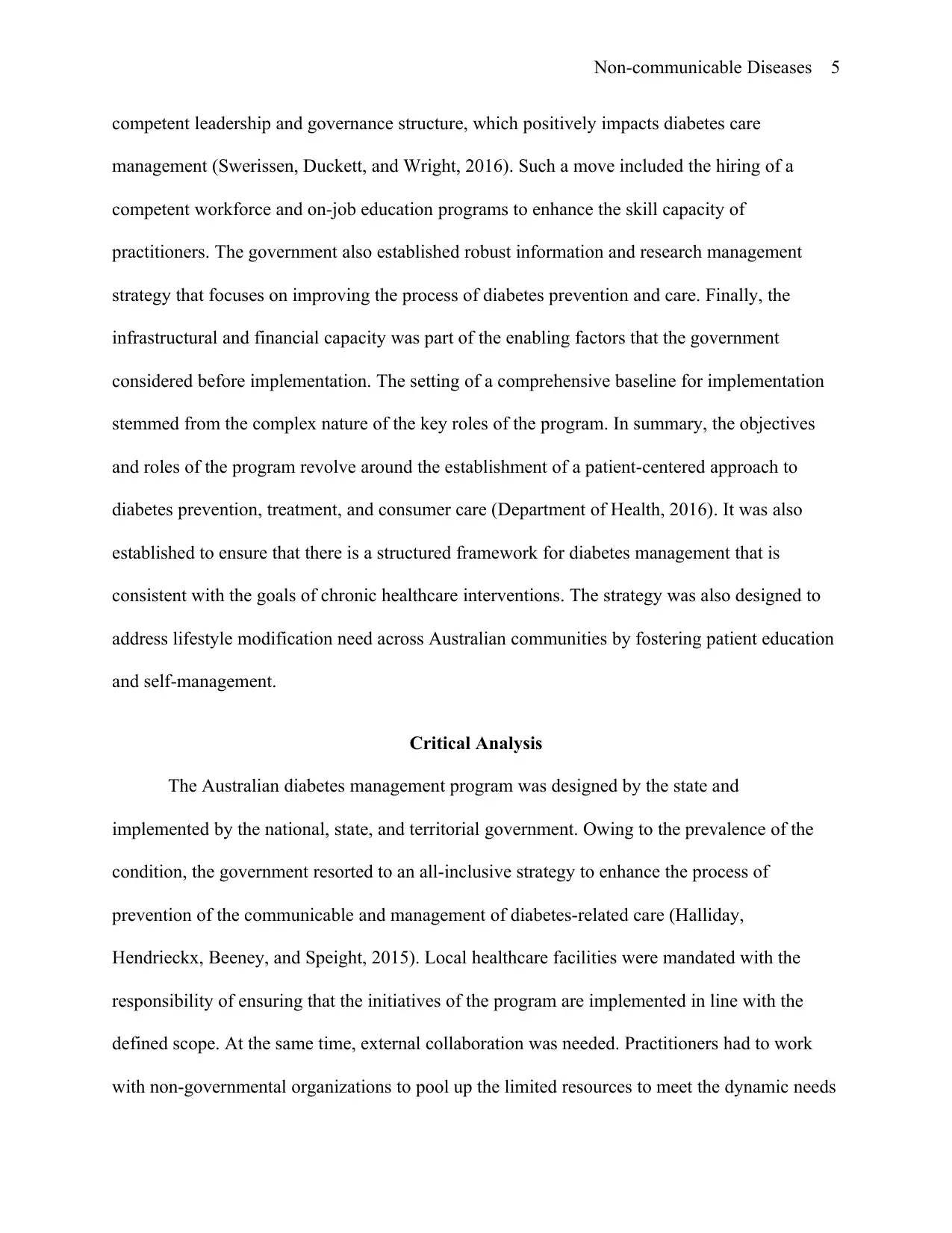
Non-communicable Diseases 5
competent leadership and governance structure, which positively impacts diabetes care
management (Swerissen, Duckett, and Wright, 2016). Such a move included the hiring of a
competent workforce and on-job education programs to enhance the skill capacity of
practitioners. The government also established robust information and research management
strategy that focuses on improving the process of diabetes prevention and care. Finally, the
infrastructural and financial capacity was part of the enabling factors that the government
considered before implementation. The setting of a comprehensive baseline for implementation
stemmed from the complex nature of the key roles of the program. In summary, the objectives
and roles of the program revolve around the establishment of a patient-centered approach to
diabetes prevention, treatment, and consumer care (Department of Health, 2016). It was also
established to ensure that there is a structured framework for diabetes management that is
consistent with the goals of chronic healthcare interventions. The strategy was also designed to
address lifestyle modification need across Australian communities by fostering patient education
and self-management.
Critical Analysis
The Australian diabetes management program was designed by the state and
implemented by the national, state, and territorial government. Owing to the prevalence of the
condition, the government resorted to an all-inclusive strategy to enhance the process of
prevention of the communicable and management of diabetes-related care (Halliday,
Hendrieckx, Beeney, and Speight, 2015). Local healthcare facilities were mandated with the
responsibility of ensuring that the initiatives of the program are implemented in line with the
defined scope. At the same time, external collaboration was needed. Practitioners had to work
with non-governmental organizations to pool up the limited resources to meet the dynamic needs
competent leadership and governance structure, which positively impacts diabetes care
management (Swerissen, Duckett, and Wright, 2016). Such a move included the hiring of a
competent workforce and on-job education programs to enhance the skill capacity of
practitioners. The government also established robust information and research management
strategy that focuses on improving the process of diabetes prevention and care. Finally, the
infrastructural and financial capacity was part of the enabling factors that the government
considered before implementation. The setting of a comprehensive baseline for implementation
stemmed from the complex nature of the key roles of the program. In summary, the objectives
and roles of the program revolve around the establishment of a patient-centered approach to
diabetes prevention, treatment, and consumer care (Department of Health, 2016). It was also
established to ensure that there is a structured framework for diabetes management that is
consistent with the goals of chronic healthcare interventions. The strategy was also designed to
address lifestyle modification need across Australian communities by fostering patient education
and self-management.
Critical Analysis
The Australian diabetes management program was designed by the state and
implemented by the national, state, and territorial government. Owing to the prevalence of the
condition, the government resorted to an all-inclusive strategy to enhance the process of
prevention of the communicable and management of diabetes-related care (Halliday,
Hendrieckx, Beeney, and Speight, 2015). Local healthcare facilities were mandated with the
responsibility of ensuring that the initiatives of the program are implemented in line with the
defined scope. At the same time, external collaboration was needed. Practitioners had to work
with non-governmental organizations to pool up the limited resources to meet the dynamic needs
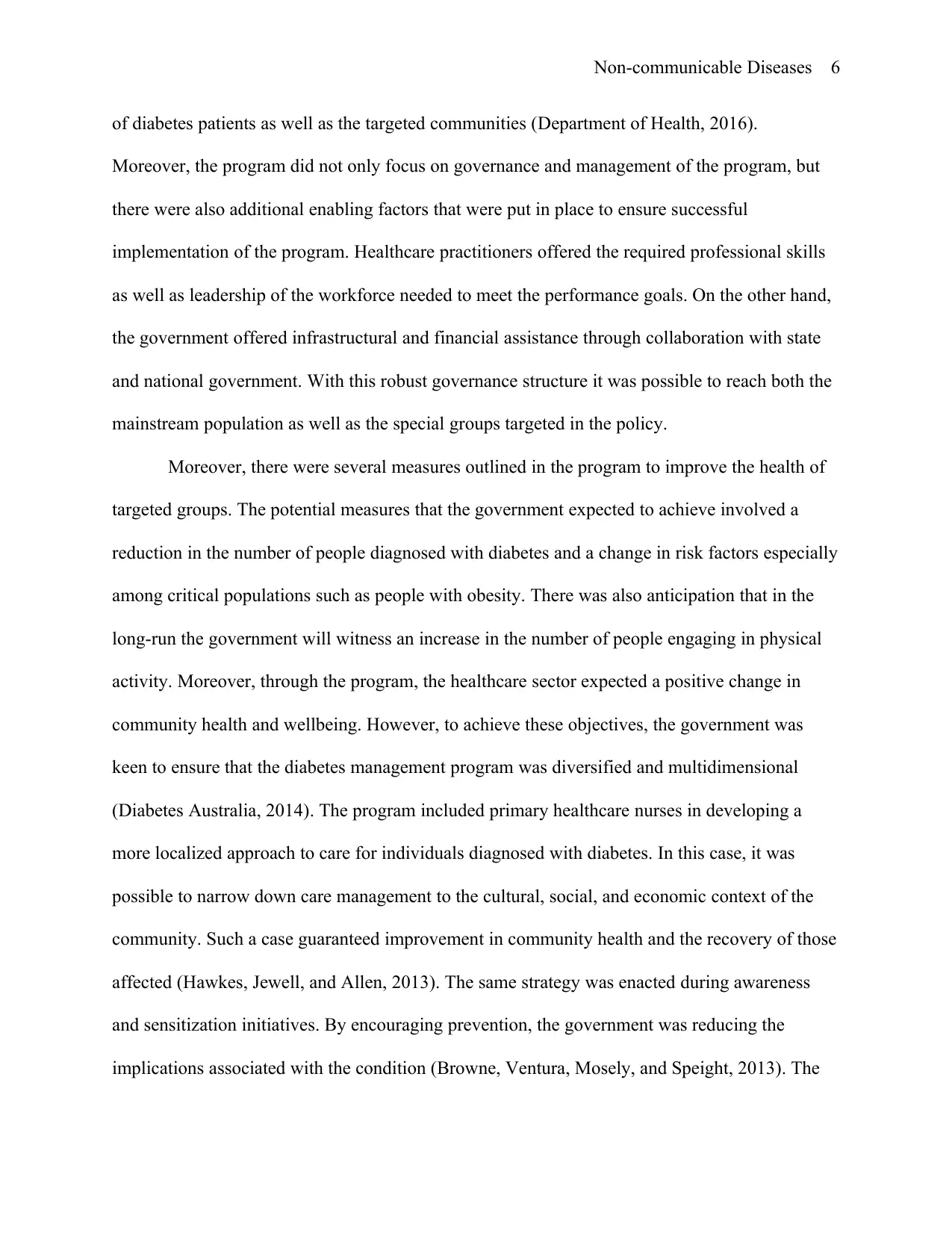
Non-communicable Diseases 6
of diabetes patients as well as the targeted communities (Department of Health, 2016).
Moreover, the program did not only focus on governance and management of the program, but
there were also additional enabling factors that were put in place to ensure successful
implementation of the program. Healthcare practitioners offered the required professional skills
as well as leadership of the workforce needed to meet the performance goals. On the other hand,
the government offered infrastructural and financial assistance through collaboration with state
and national government. With this robust governance structure it was possible to reach both the
mainstream population as well as the special groups targeted in the policy.
Moreover, there were several measures outlined in the program to improve the health of
targeted groups. The potential measures that the government expected to achieve involved a
reduction in the number of people diagnosed with diabetes and a change in risk factors especially
among critical populations such as people with obesity. There was also anticipation that in the
long-run the government will witness an increase in the number of people engaging in physical
activity. Moreover, through the program, the healthcare sector expected a positive change in
community health and wellbeing. However, to achieve these objectives, the government was
keen to ensure that the diabetes management program was diversified and multidimensional
(Diabetes Australia, 2014). The program included primary healthcare nurses in developing a
more localized approach to care for individuals diagnosed with diabetes. In this case, it was
possible to narrow down care management to the cultural, social, and economic context of the
community. Such a case guaranteed improvement in community health and the recovery of those
affected (Hawkes, Jewell, and Allen, 2013). The same strategy was enacted during awareness
and sensitization initiatives. By encouraging prevention, the government was reducing the
implications associated with the condition (Browne, Ventura, Mosely, and Speight, 2013). The
of diabetes patients as well as the targeted communities (Department of Health, 2016).
Moreover, the program did not only focus on governance and management of the program, but
there were also additional enabling factors that were put in place to ensure successful
implementation of the program. Healthcare practitioners offered the required professional skills
as well as leadership of the workforce needed to meet the performance goals. On the other hand,
the government offered infrastructural and financial assistance through collaboration with state
and national government. With this robust governance structure it was possible to reach both the
mainstream population as well as the special groups targeted in the policy.
Moreover, there were several measures outlined in the program to improve the health of
targeted groups. The potential measures that the government expected to achieve involved a
reduction in the number of people diagnosed with diabetes and a change in risk factors especially
among critical populations such as people with obesity. There was also anticipation that in the
long-run the government will witness an increase in the number of people engaging in physical
activity. Moreover, through the program, the healthcare sector expected a positive change in
community health and wellbeing. However, to achieve these objectives, the government was
keen to ensure that the diabetes management program was diversified and multidimensional
(Diabetes Australia, 2014). The program included primary healthcare nurses in developing a
more localized approach to care for individuals diagnosed with diabetes. In this case, it was
possible to narrow down care management to the cultural, social, and economic context of the
community. Such a case guaranteed improvement in community health and the recovery of those
affected (Hawkes, Jewell, and Allen, 2013). The same strategy was enacted during awareness
and sensitization initiatives. By encouraging prevention, the government was reducing the
implications associated with the condition (Browne, Ventura, Mosely, and Speight, 2013). The
You're viewing a preview
Unlock full access by subscribing today!
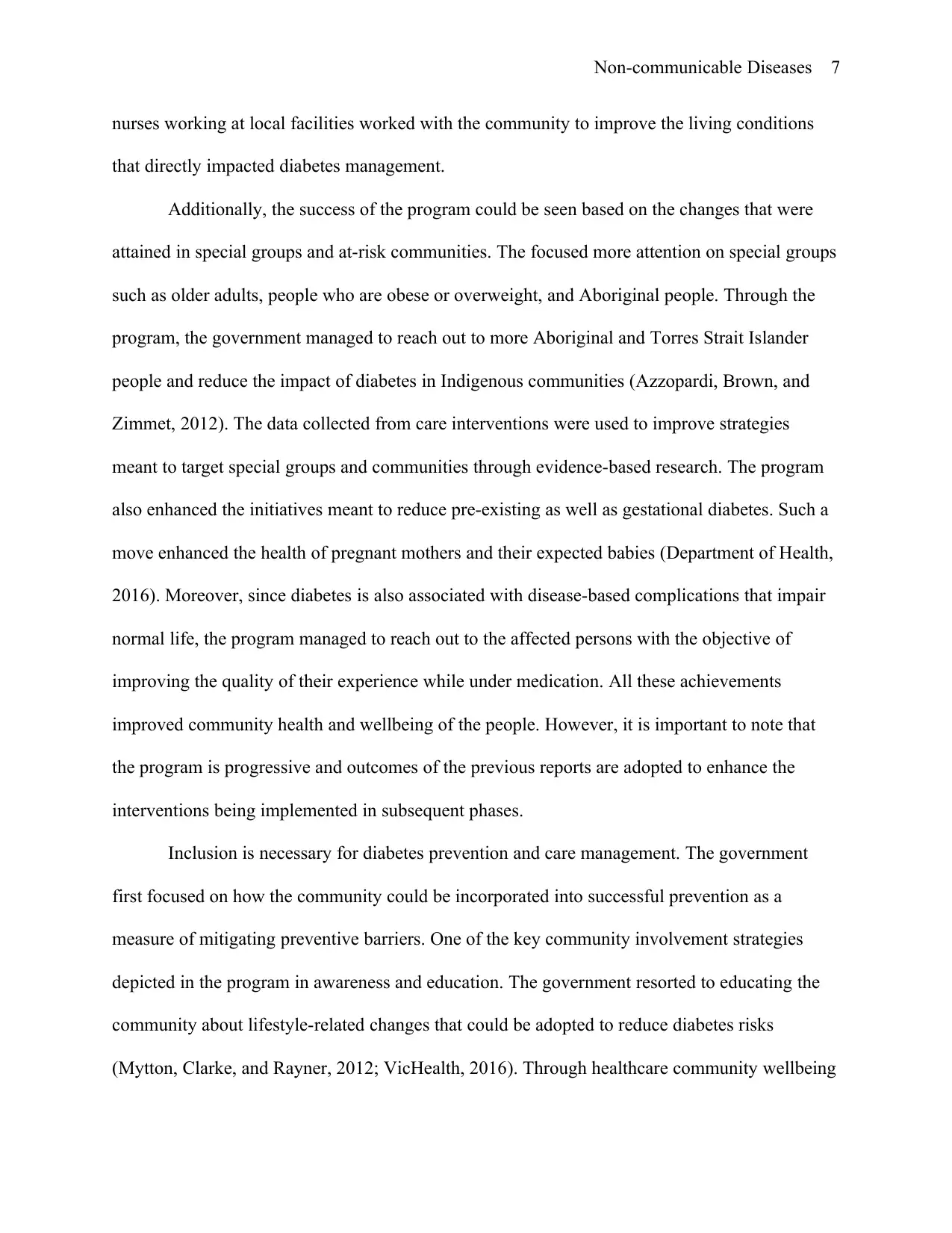
Non-communicable Diseases 7
nurses working at local facilities worked with the community to improve the living conditions
that directly impacted diabetes management.
Additionally, the success of the program could be seen based on the changes that were
attained in special groups and at-risk communities. The focused more attention on special groups
such as older adults, people who are obese or overweight, and Aboriginal people. Through the
program, the government managed to reach out to more Aboriginal and Torres Strait Islander
people and reduce the impact of diabetes in Indigenous communities (Azzopardi, Brown, and
Zimmet, 2012). The data collected from care interventions were used to improve strategies
meant to target special groups and communities through evidence-based research. The program
also enhanced the initiatives meant to reduce pre-existing as well as gestational diabetes. Such a
move enhanced the health of pregnant mothers and their expected babies (Department of Health,
2016). Moreover, since diabetes is also associated with disease-based complications that impair
normal life, the program managed to reach out to the affected persons with the objective of
improving the quality of their experience while under medication. All these achievements
improved community health and wellbeing of the people. However, it is important to note that
the program is progressive and outcomes of the previous reports are adopted to enhance the
interventions being implemented in subsequent phases.
Inclusion is necessary for diabetes prevention and care management. The government
first focused on how the community could be incorporated into successful prevention as a
measure of mitigating preventive barriers. One of the key community involvement strategies
depicted in the program in awareness and education. The government resorted to educating the
community about lifestyle-related changes that could be adopted to reduce diabetes risks
(Mytton, Clarke, and Rayner, 2012; VicHealth, 2016). Through healthcare community wellbeing
nurses working at local facilities worked with the community to improve the living conditions
that directly impacted diabetes management.
Additionally, the success of the program could be seen based on the changes that were
attained in special groups and at-risk communities. The focused more attention on special groups
such as older adults, people who are obese or overweight, and Aboriginal people. Through the
program, the government managed to reach out to more Aboriginal and Torres Strait Islander
people and reduce the impact of diabetes in Indigenous communities (Azzopardi, Brown, and
Zimmet, 2012). The data collected from care interventions were used to improve strategies
meant to target special groups and communities through evidence-based research. The program
also enhanced the initiatives meant to reduce pre-existing as well as gestational diabetes. Such a
move enhanced the health of pregnant mothers and their expected babies (Department of Health,
2016). Moreover, since diabetes is also associated with disease-based complications that impair
normal life, the program managed to reach out to the affected persons with the objective of
improving the quality of their experience while under medication. All these achievements
improved community health and wellbeing of the people. However, it is important to note that
the program is progressive and outcomes of the previous reports are adopted to enhance the
interventions being implemented in subsequent phases.
Inclusion is necessary for diabetes prevention and care management. The government
first focused on how the community could be incorporated into successful prevention as a
measure of mitigating preventive barriers. One of the key community involvement strategies
depicted in the program in awareness and education. The government resorted to educating the
community about lifestyle-related changes that could be adopted to reduce diabetes risks
(Mytton, Clarke, and Rayner, 2012; VicHealth, 2016). Through healthcare community wellbeing
Paraphrase This Document
Need a fresh take? Get an instant paraphrase of this document with our AI Paraphraser
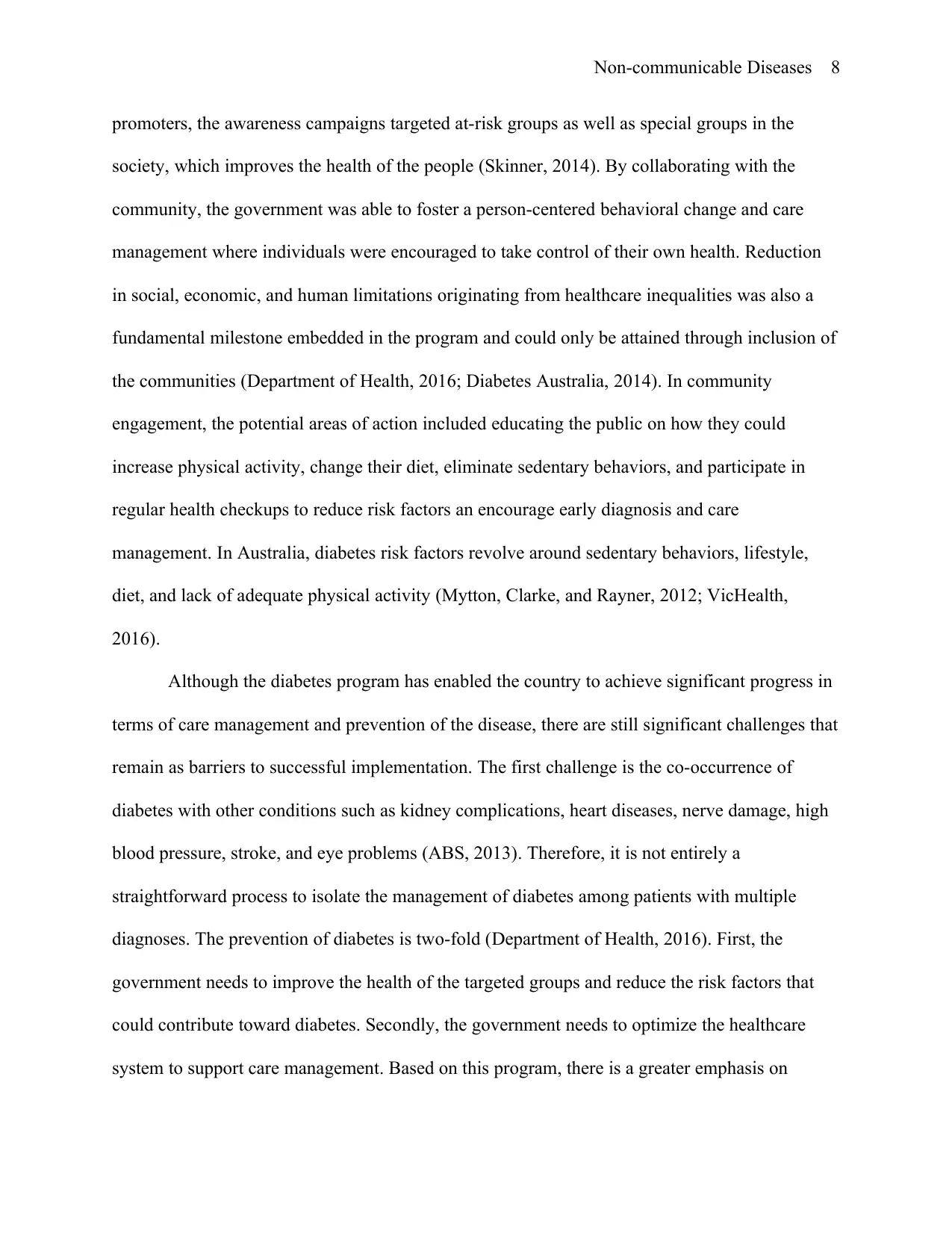
Non-communicable Diseases 8
promoters, the awareness campaigns targeted at-risk groups as well as special groups in the
society, which improves the health of the people (Skinner, 2014). By collaborating with the
community, the government was able to foster a person-centered behavioral change and care
management where individuals were encouraged to take control of their own health. Reduction
in social, economic, and human limitations originating from healthcare inequalities was also a
fundamental milestone embedded in the program and could only be attained through inclusion of
the communities (Department of Health, 2016; Diabetes Australia, 2014). In community
engagement, the potential areas of action included educating the public on how they could
increase physical activity, change their diet, eliminate sedentary behaviors, and participate in
regular health checkups to reduce risk factors an encourage early diagnosis and care
management. In Australia, diabetes risk factors revolve around sedentary behaviors, lifestyle,
diet, and lack of adequate physical activity (Mytton, Clarke, and Rayner, 2012; VicHealth,
2016).
Although the diabetes program has enabled the country to achieve significant progress in
terms of care management and prevention of the disease, there are still significant challenges that
remain as barriers to successful implementation. The first challenge is the co-occurrence of
diabetes with other conditions such as kidney complications, heart diseases, nerve damage, high
blood pressure, stroke, and eye problems (ABS, 2013). Therefore, it is not entirely a
straightforward process to isolate the management of diabetes among patients with multiple
diagnoses. The prevention of diabetes is two-fold (Department of Health, 2016). First, the
government needs to improve the health of the targeted groups and reduce the risk factors that
could contribute toward diabetes. Secondly, the government needs to optimize the healthcare
system to support care management. Based on this program, there is a greater emphasis on
promoters, the awareness campaigns targeted at-risk groups as well as special groups in the
society, which improves the health of the people (Skinner, 2014). By collaborating with the
community, the government was able to foster a person-centered behavioral change and care
management where individuals were encouraged to take control of their own health. Reduction
in social, economic, and human limitations originating from healthcare inequalities was also a
fundamental milestone embedded in the program and could only be attained through inclusion of
the communities (Department of Health, 2016; Diabetes Australia, 2014). In community
engagement, the potential areas of action included educating the public on how they could
increase physical activity, change their diet, eliminate sedentary behaviors, and participate in
regular health checkups to reduce risk factors an encourage early diagnosis and care
management. In Australia, diabetes risk factors revolve around sedentary behaviors, lifestyle,
diet, and lack of adequate physical activity (Mytton, Clarke, and Rayner, 2012; VicHealth,
2016).
Although the diabetes program has enabled the country to achieve significant progress in
terms of care management and prevention of the disease, there are still significant challenges that
remain as barriers to successful implementation. The first challenge is the co-occurrence of
diabetes with other conditions such as kidney complications, heart diseases, nerve damage, high
blood pressure, stroke, and eye problems (ABS, 2013). Therefore, it is not entirely a
straightforward process to isolate the management of diabetes among patients with multiple
diagnoses. The prevention of diabetes is two-fold (Department of Health, 2016). First, the
government needs to improve the health of the targeted groups and reduce the risk factors that
could contribute toward diabetes. Secondly, the government needs to optimize the healthcare
system to support care management. Based on this program, there is a greater emphasis on
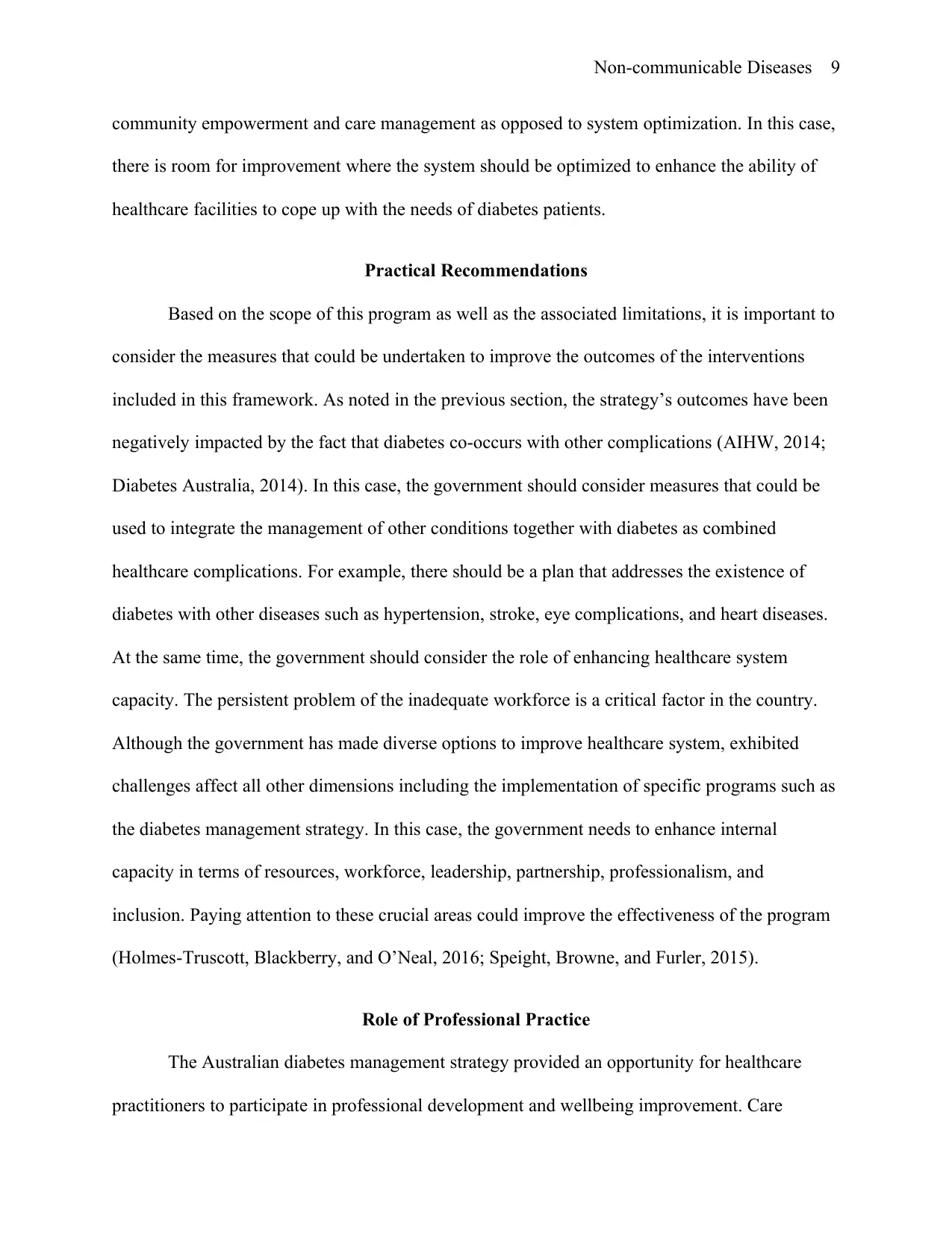
Non-communicable Diseases 9
community empowerment and care management as opposed to system optimization. In this case,
there is room for improvement where the system should be optimized to enhance the ability of
healthcare facilities to cope up with the needs of diabetes patients.
Practical Recommendations
Based on the scope of this program as well as the associated limitations, it is important to
consider the measures that could be undertaken to improve the outcomes of the interventions
included in this framework. As noted in the previous section, the strategy’s outcomes have been
negatively impacted by the fact that diabetes co-occurs with other complications (AIHW, 2014;
Diabetes Australia, 2014). In this case, the government should consider measures that could be
used to integrate the management of other conditions together with diabetes as combined
healthcare complications. For example, there should be a plan that addresses the existence of
diabetes with other diseases such as hypertension, stroke, eye complications, and heart diseases.
At the same time, the government should consider the role of enhancing healthcare system
capacity. The persistent problem of the inadequate workforce is a critical factor in the country.
Although the government has made diverse options to improve healthcare system, exhibited
challenges affect all other dimensions including the implementation of specific programs such as
the diabetes management strategy. In this case, the government needs to enhance internal
capacity in terms of resources, workforce, leadership, partnership, professionalism, and
inclusion. Paying attention to these crucial areas could improve the effectiveness of the program
(Holmes-Truscott, Blackberry, and O’Neal, 2016; Speight, Browne, and Furler, 2015).
Role of Professional Practice
The Australian diabetes management strategy provided an opportunity for healthcare
practitioners to participate in professional development and wellbeing improvement. Care
community empowerment and care management as opposed to system optimization. In this case,
there is room for improvement where the system should be optimized to enhance the ability of
healthcare facilities to cope up with the needs of diabetes patients.
Practical Recommendations
Based on the scope of this program as well as the associated limitations, it is important to
consider the measures that could be undertaken to improve the outcomes of the interventions
included in this framework. As noted in the previous section, the strategy’s outcomes have been
negatively impacted by the fact that diabetes co-occurs with other complications (AIHW, 2014;
Diabetes Australia, 2014). In this case, the government should consider measures that could be
used to integrate the management of other conditions together with diabetes as combined
healthcare complications. For example, there should be a plan that addresses the existence of
diabetes with other diseases such as hypertension, stroke, eye complications, and heart diseases.
At the same time, the government should consider the role of enhancing healthcare system
capacity. The persistent problem of the inadequate workforce is a critical factor in the country.
Although the government has made diverse options to improve healthcare system, exhibited
challenges affect all other dimensions including the implementation of specific programs such as
the diabetes management strategy. In this case, the government needs to enhance internal
capacity in terms of resources, workforce, leadership, partnership, professionalism, and
inclusion. Paying attention to these crucial areas could improve the effectiveness of the program
(Holmes-Truscott, Blackberry, and O’Neal, 2016; Speight, Browne, and Furler, 2015).
Role of Professional Practice
The Australian diabetes management strategy provided an opportunity for healthcare
practitioners to participate in professional development and wellbeing improvement. Care
You're viewing a preview
Unlock full access by subscribing today!
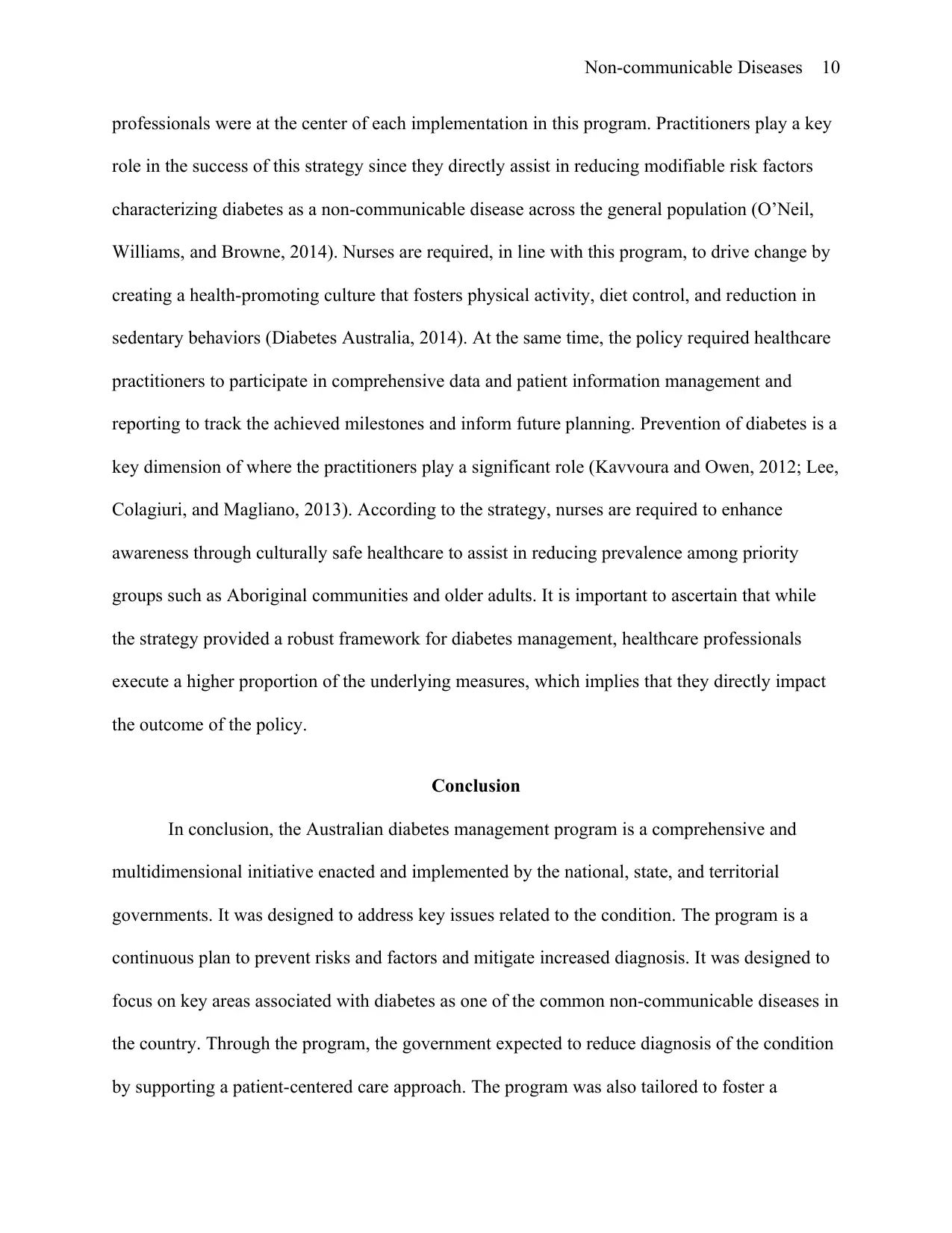
Non-communicable Diseases 10
professionals were at the center of each implementation in this program. Practitioners play a key
role in the success of this strategy since they directly assist in reducing modifiable risk factors
characterizing diabetes as a non-communicable disease across the general population (O’Neil,
Williams, and Browne, 2014). Nurses are required, in line with this program, to drive change by
creating a health-promoting culture that fosters physical activity, diet control, and reduction in
sedentary behaviors (Diabetes Australia, 2014). At the same time, the policy required healthcare
practitioners to participate in comprehensive data and patient information management and
reporting to track the achieved milestones and inform future planning. Prevention of diabetes is a
key dimension of where the practitioners play a significant role (Kavvoura and Owen, 2012; Lee,
Colagiuri, and Magliano, 2013). According to the strategy, nurses are required to enhance
awareness through culturally safe healthcare to assist in reducing prevalence among priority
groups such as Aboriginal communities and older adults. It is important to ascertain that while
the strategy provided a robust framework for diabetes management, healthcare professionals
execute a higher proportion of the underlying measures, which implies that they directly impact
the outcome of the policy.
Conclusion
In conclusion, the Australian diabetes management program is a comprehensive and
multidimensional initiative enacted and implemented by the national, state, and territorial
governments. It was designed to address key issues related to the condition. The program is a
continuous plan to prevent risks and factors and mitigate increased diagnosis. It was designed to
focus on key areas associated with diabetes as one of the common non-communicable diseases in
the country. Through the program, the government expected to reduce diagnosis of the condition
by supporting a patient-centered care approach. The program was also tailored to foster a
professionals were at the center of each implementation in this program. Practitioners play a key
role in the success of this strategy since they directly assist in reducing modifiable risk factors
characterizing diabetes as a non-communicable disease across the general population (O’Neil,
Williams, and Browne, 2014). Nurses are required, in line with this program, to drive change by
creating a health-promoting culture that fosters physical activity, diet control, and reduction in
sedentary behaviors (Diabetes Australia, 2014). At the same time, the policy required healthcare
practitioners to participate in comprehensive data and patient information management and
reporting to track the achieved milestones and inform future planning. Prevention of diabetes is a
key dimension of where the practitioners play a significant role (Kavvoura and Owen, 2012; Lee,
Colagiuri, and Magliano, 2013). According to the strategy, nurses are required to enhance
awareness through culturally safe healthcare to assist in reducing prevalence among priority
groups such as Aboriginal communities and older adults. It is important to ascertain that while
the strategy provided a robust framework for diabetes management, healthcare professionals
execute a higher proportion of the underlying measures, which implies that they directly impact
the outcome of the policy.
Conclusion
In conclusion, the Australian diabetes management program is a comprehensive and
multidimensional initiative enacted and implemented by the national, state, and territorial
governments. It was designed to address key issues related to the condition. The program is a
continuous plan to prevent risks and factors and mitigate increased diagnosis. It was designed to
focus on key areas associated with diabetes as one of the common non-communicable diseases in
the country. Through the program, the government expected to reduce diagnosis of the condition
by supporting a patient-centered care approach. The program was also tailored to foster a
Paraphrase This Document
Need a fresh take? Get an instant paraphrase of this document with our AI Paraphraser
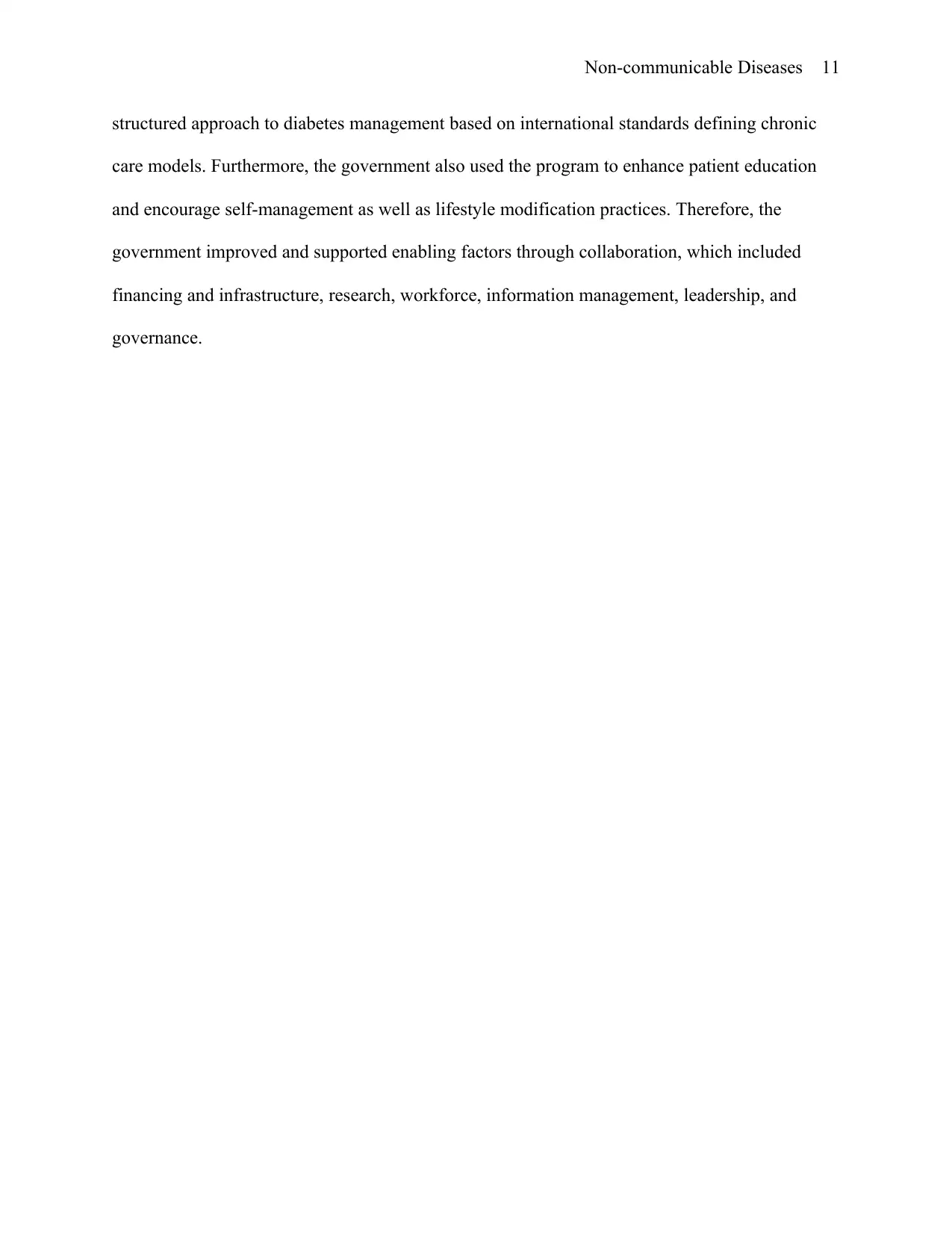
Non-communicable Diseases 11
structured approach to diabetes management based on international standards defining chronic
care models. Furthermore, the government also used the program to enhance patient education
and encourage self-management as well as lifestyle modification practices. Therefore, the
government improved and supported enabling factors through collaboration, which included
financing and infrastructure, research, workforce, information management, leadership, and
governance.
structured approach to diabetes management based on international standards defining chronic
care models. Furthermore, the government also used the program to enhance patient education
and encourage self-management as well as lifestyle modification practices. Therefore, the
government improved and supported enabling factors through collaboration, which included
financing and infrastructure, research, workforce, information management, leadership, and
governance.
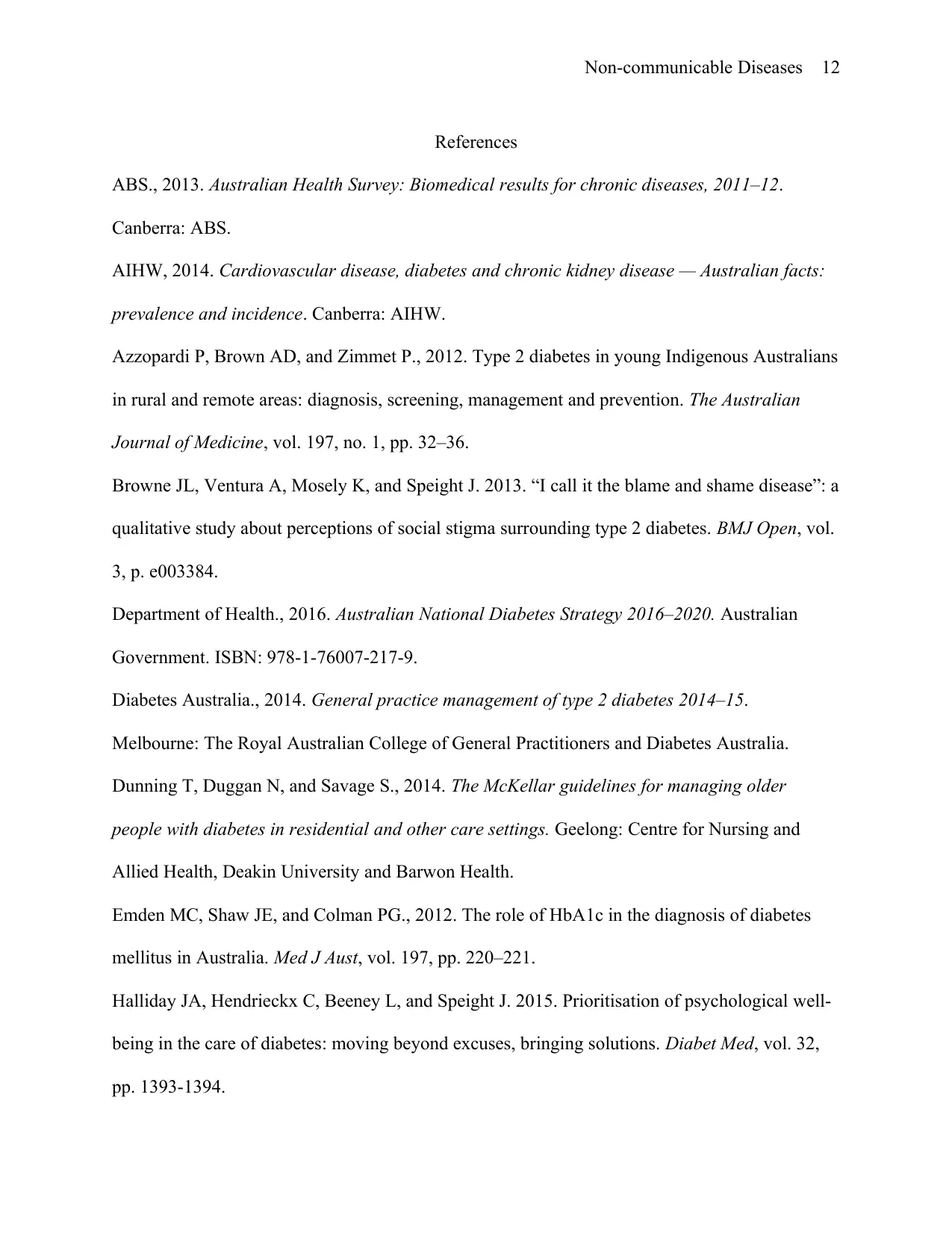
Non-communicable Diseases 12
References
ABS., 2013. Australian Health Survey: Biomedical results for chronic diseases, 2011–12.
Canberra: ABS.
AIHW, 2014. Cardiovascular disease, diabetes and chronic kidney disease — Australian facts:
prevalence and incidence. Canberra: AIHW.
Azzopardi P, Brown AD, and Zimmet P., 2012. Type 2 diabetes in young Indigenous Australians
in rural and remote areas: diagnosis, screening, management and prevention. The Australian
Journal of Medicine, vol. 197, no. 1, pp. 32–36.
Browne JL, Ventura A, Mosely K, and Speight J. 2013. “I call it the blame and shame disease”: a
qualitative study about perceptions of social stigma surrounding type 2 diabetes. BMJ Open, vol.
3, p. e003384.
Department of Health., 2016. Australian National Diabetes Strategy 2016–2020. Australian
Government. ISBN: 978-1-76007-217-9.
Diabetes Australia., 2014. General practice management of type 2 diabetes 2014–15.
Melbourne: The Royal Australian College of General Practitioners and Diabetes Australia.
Dunning T, Duggan N, and Savage S., 2014. The McKellar guidelines for managing older
people with diabetes in residential and other care settings. Geelong: Centre for Nursing and
Allied Health, Deakin University and Barwon Health.
Emden MC, Shaw JE, and Colman PG., 2012. The role of HbA1c in the diagnosis of diabetes
mellitus in Australia. Med J Aust, vol. 197, pp. 220–221.
Halliday JA, Hendrieckx C, Beeney L, and Speight J. 2015. Prioritisation of psychological well-
being in the care of diabetes: moving beyond excuses, bringing solutions. Diabet Med, vol. 32,
pp. 1393-1394.
References
ABS., 2013. Australian Health Survey: Biomedical results for chronic diseases, 2011–12.
Canberra: ABS.
AIHW, 2014. Cardiovascular disease, diabetes and chronic kidney disease — Australian facts:
prevalence and incidence. Canberra: AIHW.
Azzopardi P, Brown AD, and Zimmet P., 2012. Type 2 diabetes in young Indigenous Australians
in rural and remote areas: diagnosis, screening, management and prevention. The Australian
Journal of Medicine, vol. 197, no. 1, pp. 32–36.
Browne JL, Ventura A, Mosely K, and Speight J. 2013. “I call it the blame and shame disease”: a
qualitative study about perceptions of social stigma surrounding type 2 diabetes. BMJ Open, vol.
3, p. e003384.
Department of Health., 2016. Australian National Diabetes Strategy 2016–2020. Australian
Government. ISBN: 978-1-76007-217-9.
Diabetes Australia., 2014. General practice management of type 2 diabetes 2014–15.
Melbourne: The Royal Australian College of General Practitioners and Diabetes Australia.
Dunning T, Duggan N, and Savage S., 2014. The McKellar guidelines for managing older
people with diabetes in residential and other care settings. Geelong: Centre for Nursing and
Allied Health, Deakin University and Barwon Health.
Emden MC, Shaw JE, and Colman PG., 2012. The role of HbA1c in the diagnosis of diabetes
mellitus in Australia. Med J Aust, vol. 197, pp. 220–221.
Halliday JA, Hendrieckx C, Beeney L, and Speight J. 2015. Prioritisation of psychological well-
being in the care of diabetes: moving beyond excuses, bringing solutions. Diabet Med, vol. 32,
pp. 1393-1394.
You're viewing a preview
Unlock full access by subscribing today!
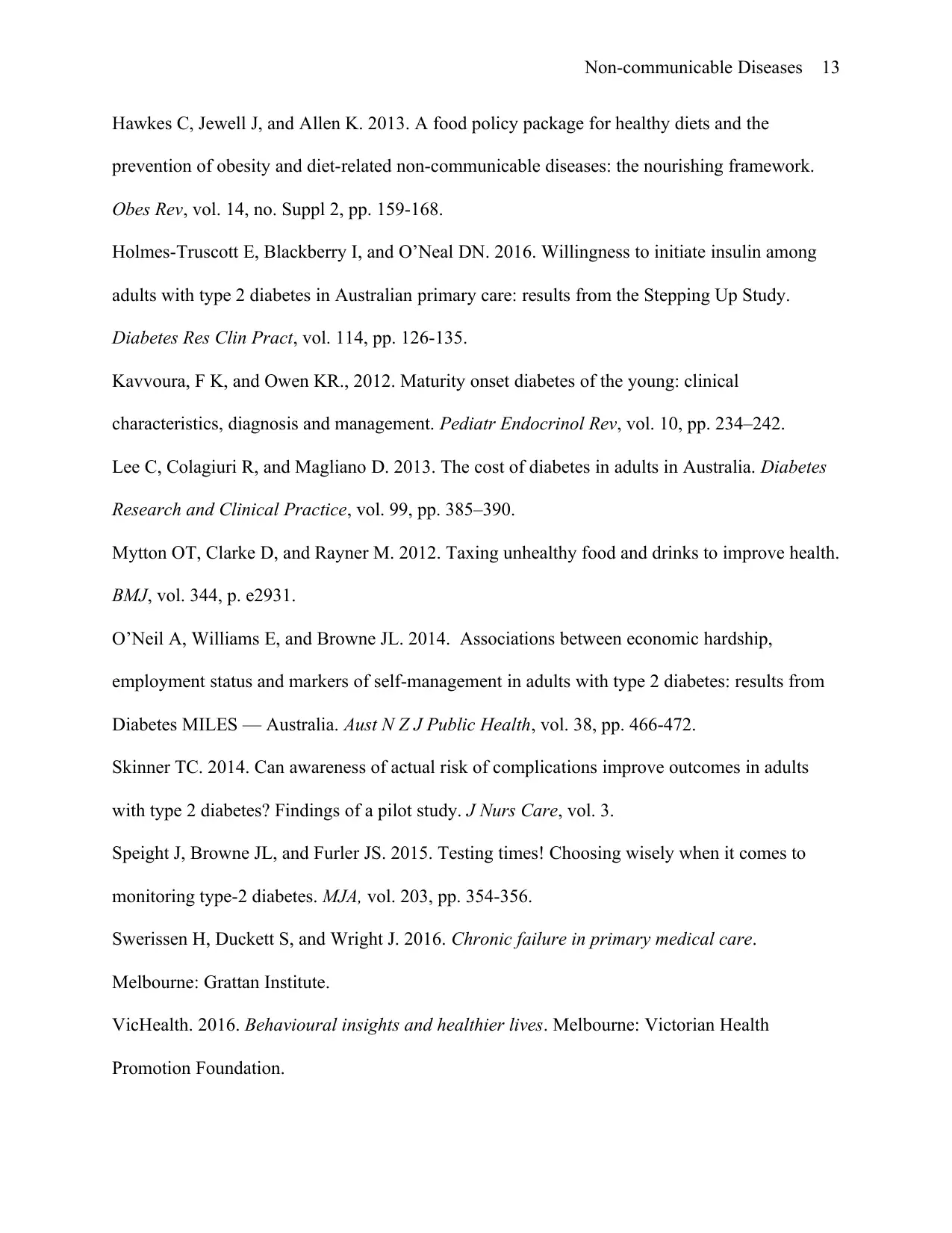
Non-communicable Diseases 13
Hawkes C, Jewell J, and Allen K. 2013. A food policy package for healthy diets and the
prevention of obesity and diet-related non-communicable diseases: the nourishing framework.
Obes Rev, vol. 14, no. Suppl 2, pp. 159-168.
Holmes-Truscott E, Blackberry I, and O’Neal DN. 2016. Willingness to initiate insulin among
adults with type 2 diabetes in Australian primary care: results from the Stepping Up Study.
Diabetes Res Clin Pract, vol. 114, pp. 126-135.
Kavvoura, F K, and Owen KR., 2012. Maturity onset diabetes of the young: clinical
characteristics, diagnosis and management. Pediatr Endocrinol Rev, vol. 10, pp. 234–242.
Lee C, Colagiuri R, and Magliano D. 2013. The cost of diabetes in adults in Australia. Diabetes
Research and Clinical Practice, vol. 99, pp. 385–390.
Mytton OT, Clarke D, and Rayner M. 2012. Taxing unhealthy food and drinks to improve health.
BMJ, vol. 344, p. e2931.
O’Neil A, Williams E, and Browne JL. 2014. Associations between economic hardship,
employment status and markers of self-management in adults with type 2 diabetes: results from
Diabetes MILES — Australia. Aust N Z J Public Health, vol. 38, pp. 466-472.
Skinner TC. 2014. Can awareness of actual risk of complications improve outcomes in adults
with type 2 diabetes? Findings of a pilot study. J Nurs Care, vol. 3.
Speight J, Browne JL, and Furler JS. 2015. Testing times! Choosing wisely when it comes to
monitoring type-2 diabetes. MJA, vol. 203, pp. 354-356.
Swerissen H, Duckett S, and Wright J. 2016. Chronic failure in primary medical care.
Melbourne: Grattan Institute.
VicHealth. 2016. Behavioural insights and healthier lives. Melbourne: Victorian Health
Promotion Foundation.
Hawkes C, Jewell J, and Allen K. 2013. A food policy package for healthy diets and the
prevention of obesity and diet-related non-communicable diseases: the nourishing framework.
Obes Rev, vol. 14, no. Suppl 2, pp. 159-168.
Holmes-Truscott E, Blackberry I, and O’Neal DN. 2016. Willingness to initiate insulin among
adults with type 2 diabetes in Australian primary care: results from the Stepping Up Study.
Diabetes Res Clin Pract, vol. 114, pp. 126-135.
Kavvoura, F K, and Owen KR., 2012. Maturity onset diabetes of the young: clinical
characteristics, diagnosis and management. Pediatr Endocrinol Rev, vol. 10, pp. 234–242.
Lee C, Colagiuri R, and Magliano D. 2013. The cost of diabetes in adults in Australia. Diabetes
Research and Clinical Practice, vol. 99, pp. 385–390.
Mytton OT, Clarke D, and Rayner M. 2012. Taxing unhealthy food and drinks to improve health.
BMJ, vol. 344, p. e2931.
O’Neil A, Williams E, and Browne JL. 2014. Associations between economic hardship,
employment status and markers of self-management in adults with type 2 diabetes: results from
Diabetes MILES — Australia. Aust N Z J Public Health, vol. 38, pp. 466-472.
Skinner TC. 2014. Can awareness of actual risk of complications improve outcomes in adults
with type 2 diabetes? Findings of a pilot study. J Nurs Care, vol. 3.
Speight J, Browne JL, and Furler JS. 2015. Testing times! Choosing wisely when it comes to
monitoring type-2 diabetes. MJA, vol. 203, pp. 354-356.
Swerissen H, Duckett S, and Wright J. 2016. Chronic failure in primary medical care.
Melbourne: Grattan Institute.
VicHealth. 2016. Behavioural insights and healthier lives. Melbourne: Victorian Health
Promotion Foundation.
Paraphrase This Document
Need a fresh take? Get an instant paraphrase of this document with our AI Paraphraser

Non-communicable Diseases 14
Wickramasinghe LK, Schattner P, Hibbert ME, Enticott JC, Georgeff MP, and Russell GM.,
2013. Impact on diabetes management of General Practice Management Plans, Team Care
Arrangements and reviews. Med J Aust, vol. 199, pp. 261–265.
Wickramasinghe LK, Schattner P, Hibbert ME, Enticott JC, Georgeff MP, and Russell GM.,
2013. Impact on diabetes management of General Practice Management Plans, Team Care
Arrangements and reviews. Med J Aust, vol. 199, pp. 261–265.
1 out of 14
Related Documents
Your All-in-One AI-Powered Toolkit for Academic Success.
+13062052269
info@desklib.com
Available 24*7 on WhatsApp / Email
![[object Object]](/_next/static/media/star-bottom.7253800d.svg)
Unlock your academic potential
© 2024 | Zucol Services PVT LTD | All rights reserved.





